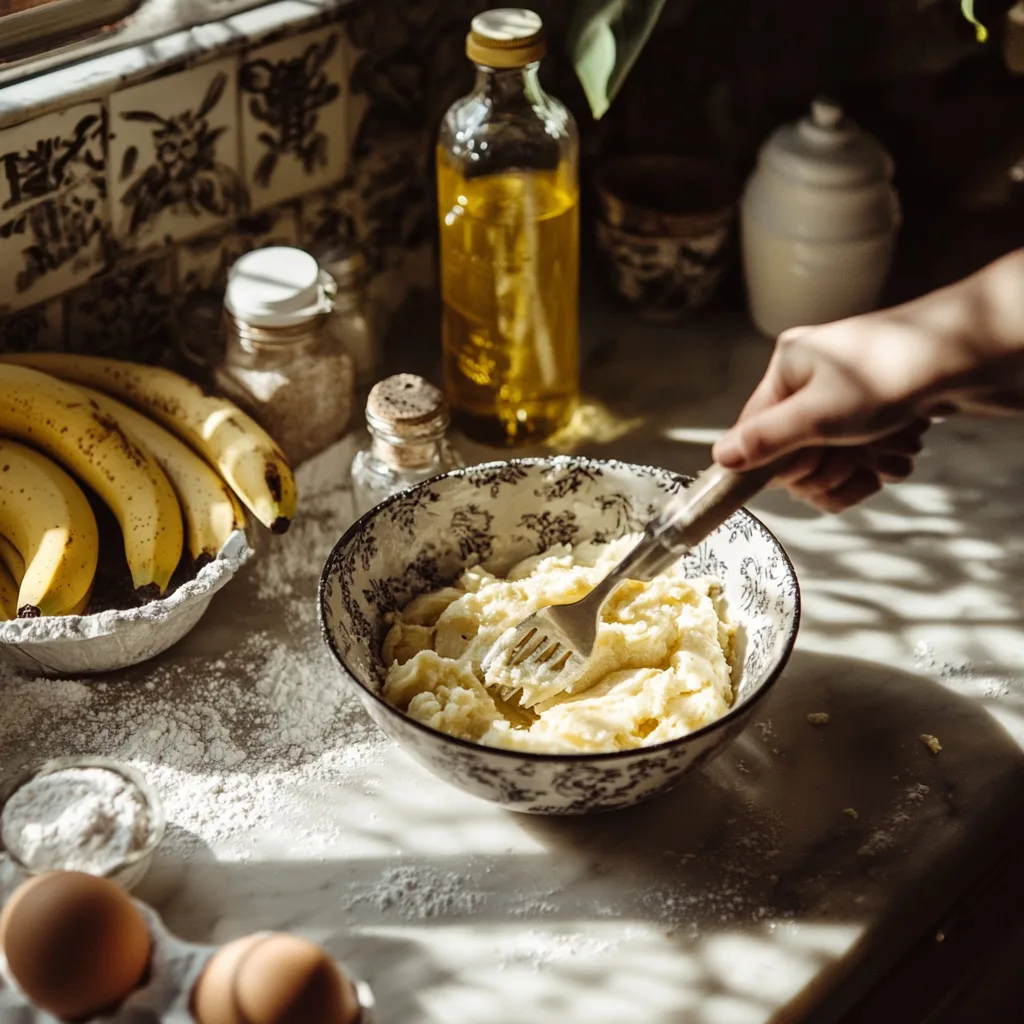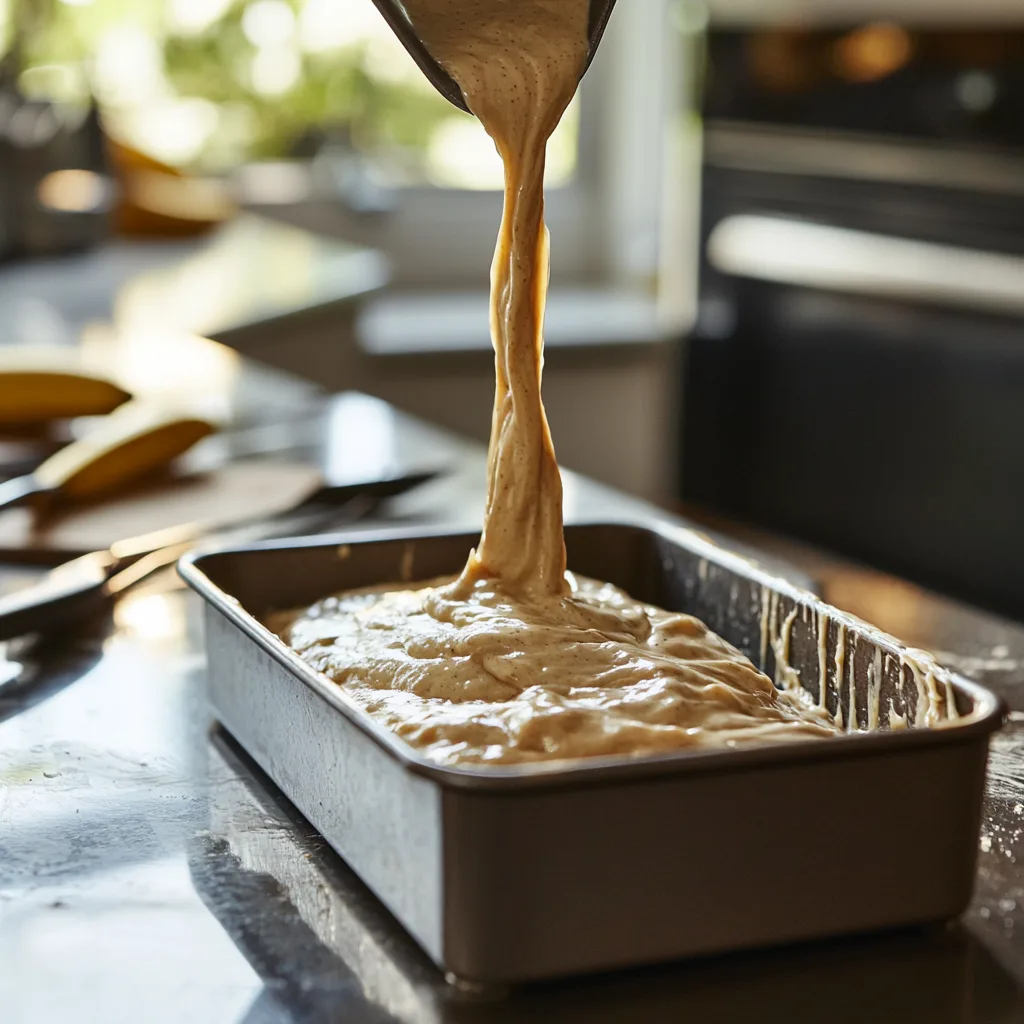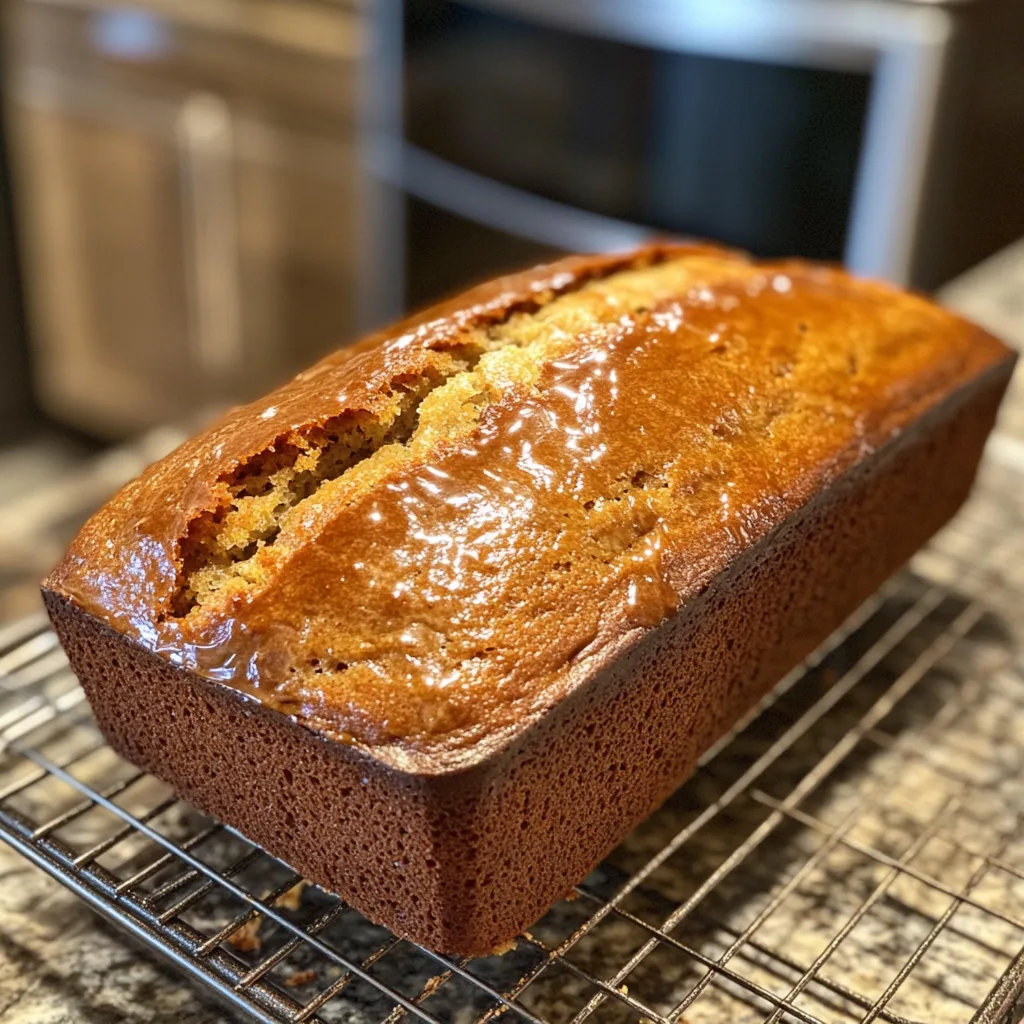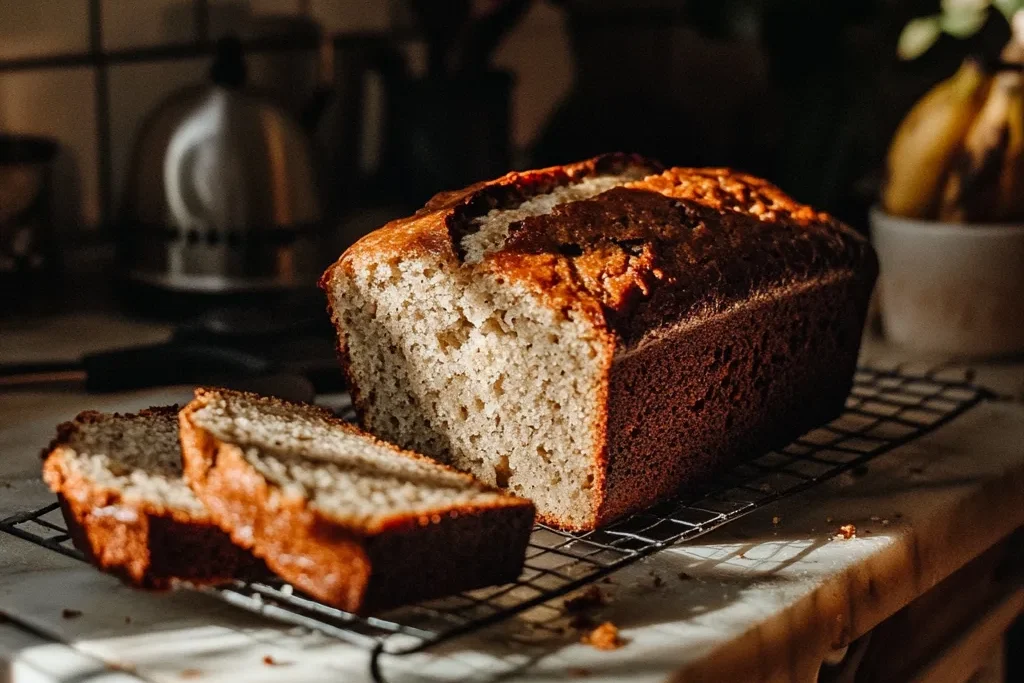Banana bread is a undying favorite, perfect for breakfast or as a comforting snack. This Ultimate Banana Bread Recipe using oil gives a scrumptious twist to the traditional, replacing butter with oil to create a wet, fluffy loaf that’s even simpler to make. The recipe capabilities simple elements like ripe bananas, oil, sugar, eggs, and primary pantry staples, resulting in a smooth, gentle bread that stays fresh for days. If you’re searching out any other clean, scrumptious breakfast option, check out our Hotcake Mix Recipe – The Ultimate Guide for a fast and attractive pancake solution
Recipe Overview:
The process is easy. Ripe bananas are mashed and blended with oil, sugar, eggs, and vanilla extract. Dry ingredients—flour, baking soda, and salt—are added to the moist elements, developing a smooth batter. Once baked, the result is a golden-brown, sweet-smelling loaf of banana bread that’s perfect for any occasion.
Benefits of Using Oil:
Moisture: Oil ensures the banana bread remains moist and soft for longer. Unlike butter, which could once in a while dry out, oil continues the loaf tender even after it cools.
Convenience: No want to await butter to melt! Oil can be added at once to the batter, simplifying the training method.
Healthier Option: Depending at the sort of oil used (like canola or olive oil), it provides healthier fat to the recipe, making it a better option than butter.
Consistent Texture: Oil creates a lighter, fluffier crumb, keeping off any heaviness or dryness that from time to time comes with butter-based banana bread.
Longer Shelf Life: Oil facilitates keep the moisture within the bread, allowing it to live clean and delicious for several days.

Table of Contents
Why Use Oil in Banana Bread?
Using oil in banana bread instead of butter brings a host of benefits that can take your loaf to the next level. Here’s why you might want to consider making the switch:
- Moisture Retention
Oil helps to keep banana bread incredibly moist. Unlike butter, which can dry out as the bread cools, oil locks in moisture, ensuring your loaf stays soft and tender for longer. This is especially helpful for banana bread, which benefits from a rich, moist texture. - Softer, Fluffier Texture
Oil tends to produce a lighter and fluffier crumb. It contributes to the bread’s soft, melt-in-your-mouth texture, making it feel less dense than butter-based banana bread. The oil helps create an airy texture that’s perfect for a satisfying bite. - Longer Freshness
Banana bread made with oil stays fresh for several days, compared to butter-based versions that may start to dry out. The oil acts as a preservative, maintaining the bread’s moisture and flavor long after baking. - No Need for Softening
When you use oil, there’s no need to wait for butter to soften. This makes the preparation process quicker and easier. Just measure and mix—the oil combines seamlessly with the rest of the ingredients, saving time and effort in the kitchen. - Healthier Fat Option
Depending on the type of oil you use (like canola oil or olive oil), it can be a healthier fat alternative to butter. These oils contain unsaturated fats, which are considered better for your heart health compared to the saturated fats found in butter. - Neutral Flavor
Oil has a neutral taste, allowing the flavors of the bananas and other ingredients to really shine. Butter, on the other hand, can sometimes have a stronger flavor that might overpower the bananas. The subtlety of oil allows the banana flavor to take center stage.
Key Ingredients for a Perfect Banana Bread
The key to a perfect banana bread lies in the quality and balance of ingredients. Here’s what you need for that soft, moist loaf:
Ripe Bananas: The riper, the better! Overripe bananas add sweetness and moisture, making the bread rich and flavorful. Aim for 3 medium bananas.
Flour: All-purpose flour is the base of your banana bread. It gives structure and texture. You’ll need about 2 cups.
Sugar: Banana bread needs sweetness, and granulated sugar or brown sugar is typically used. Brown sugar adds a bit of caramel flavor. About 1 cup is ideal.
Eggs: Eggs bind the ingredients and provide moisture. Two large eggs help with structure and rise.
Oil or Butter: Oil (like canola or vegetable) gives the bread a moist, soft texture that lasts longer. Butter adds richness and flavor. Use about 1/2 cup.
Baking Soda: This is essential for rise and fluffiness. About 1 teaspoon is needed to react with the bananas’ acidity.
Salt: A small pinch (about 1/2 teaspoon) balances the sweetness and enhances flavor.
Vanilla Extract: Adds depth and warmth to the flavor—just 1 teaspoon.
Step-by-Step Banana Bread Recipe Using Oil

This banana bread using oil is quick, easy, and delivers a moist, fluffy loaf that stays fresh for days. Here’s a simple guide to making the perfect banana bread!
Ingredients:
3 ripe bananas, mashed
1/2 cup vegetable oil (or canola oil)
1 cup granulated sugar (or brown sugar for a richer taste)
2 large eggs, at room temperature
1 tsp vanilla extract
2 cups all-purpose flour
1 tsp baking soda
1/2 tsp salt
Instructions:
Preheat the Oven: Start by preheating your oven to 350°F (175°C). Grease and flour a 9×5-inch loaf pan or line it with parchment paper.
Mash the Bananas: Peel your ripe bananas and place them in a large bowl. Mash them with a fork until smooth but slightly chunky. The more overripe, the better—it adds flavor and moisture.
Mix Wet Ingredients: In the same bowl, add the oil, sugar, eggs, and vanilla extract to the mashed bananas. Stir until the mixture is well combined.
Combine Dry Ingredients: In a separate bowl, whisk together the flour, baking soda, and salt. This helps evenly distribute the dry ingredients and avoid clumps in the batter.
Add Dry to Wet: Gradually add the dry ingredients to the wet banana mixture. Stir gently until just combined. Be careful not to overmix—lumps are fine, and overmixing can make the bread dense.
Pour and Bake: Pour the batter into the prepared loaf pan and spread it evenly. Bake in the preheated oven for about 60-65 minutes, or until a toothpick inserted in the center comes out clean.
Cool and Serve: Let the banana bread cool in the pan for 10-15 minutes before transferring it to a wire rack. Slice and enjoy!
Tips for Perfect Banana Bread
Want to make sure your banana bread comes out moist, fluffy, and full of flavor every time? Here are some helpful tips to take your banana bread game to the next level:
- Use Overripe Bananas
The riper the bananas, the better! Look for bananas that are overripe with brown spots. They’re sweeter and softer, adding more moisture and flavor to your banana bread. The more brown, the better! - Don’t Overmix the Batter
When combining the wet and dry ingredients, mix just until combined. Overmixing can lead to tough banana bread, as it activates the gluten in the flour. A few lumps in the batter are totally fine! - Add Moisture with Oil
Using oil instead of butter in your banana bread recipe keeps it extra moist and tender. Plus, oil helps the bread stay fresh longer. Stick with a neutral oil like vegetable or canola to let the banana flavor shine. - Check for Doneness with a Toothpick
To make sure your bread is baked all the way through, insert a toothpick into the center. If it comes out clean or with a few moist crumbs, your banana bread is ready. If there’s batter on the toothpick, give it another 5-10 minutes and check again. - Let It Cool Before Slicing
Resist the urge to slice into your banana bread right away. Let it cool in the pan for 10-15 minutes to set properly before transferring it to a cooling rack. This will help prevent the bread from falling apart. - Don’t Skip the Parchment Paper or Grease
Make sure your loaf pan is well-greased or lined with parchment paper to avoid sticking. You don’t want to ruin that perfect loaf by struggling to get it out of the pan! - Add Fun Extras
Want to mix things up? Add-ins like chocolate chips, nuts, or even dried fruit give your banana bread an extra pop of flavor and texture. Add about 1/2 cup of mix-ins for a fun twist. - Store Properly for Freshness
Once your banana bread has cooled, wrap it in plastic wrap or store it in an airtight container to keep it fresh. It can stay at room temperature for up to 4 days, or you can freeze it for later!
Variations of Banana Bread Using Oil
While classic banana bread is delicious on its own, there are plenty of fun variations you can try using oil to switch things up! Here are a few ideas to take your banana bread to the next level:
- Chocolate Chip Banana Bread
Add chocolate chips to your banana bread for a sweet, indulgent twist. About 1/2 cup of semi-sweet or dark chocolate chips will melt into the bread, creating pockets of gooey goodness. - Nutty Banana Bread
For some extra crunch and flavor, fold in chopped walnuts or pecans. These nuts pair perfectly with the sweet bananas and add a delightful texture. About 1/2 cup is enough to give a nutty bite. - Cinnamon Banana Bread
Sprinkle a little cinnamon into the batter for a warm, spicy flavor. You can also swirl a teaspoon of cinnamon sugar into the loaf before baking for an extra sweet touch. - Peanut Butter Banana Bread
Add a swirl of peanut butter to the batter for a creamy, nutty flavor that pairs wonderfully with banana. Just drop spoonfuls of peanut butter into the batter and swirl it gently with a knife. - Zucchini Banana Bread
For a healthier variation, try adding shredded zucchini to your banana bread. It adds moisture and a slight veggie twist without altering the flavor too much.

Troubleshooting Common Banana Bread Issues
Even with the best ingredients, banana bread can sometimes fall short. Here are some common issues and how to fix them:
- Dense Banana Bread
If your banana bread is too dense, you might have overmixed the batter. Overmixing activates the gluten in the flour, making the bread heavy. Tip: Stir gently until the ingredients are just combined, leaving some lumps. - Dry or Crumbly Texture
Dry banana bread can be caused by too much flour or overbaking. Tip: Make sure you measure the flour correctly (spoon and level method) and avoid overbaking. Check for doneness 5-10 minutes before the suggested baking time by inserting a toothpick—it should come out with a few moist crumbs. - Bread Sinks in the Middle
If your banana bread sinks in the middle, it might have been underbaked or the oven temperature was too low. Tip: Always check your oven’s temperature with a thermometer. Ensure the bread is cooked through by testing with a toothpick. - Bread Sticking to the Pan
If the bread sticks, it could be due to insufficient greasing or not using parchment paper. Tip: Grease your pan well or line it with parchment paper to make removing the bread easier.
Conclusion
Banana bread the use of oil is a simple, delicious treat that’s ideal for any occasion. By following some key steps and suggestions, you can create a wet, flavorful loaf each time. Whether you’re the use of overripe bananas, including chocolate chips or nuts, or honestly playing it on its very own, banana bread is a comforting classic that in no way goes out of favor. With the right ingredients and a touch exercise, you’ll have the proper banana bread—smooth, tender, and bursting with banana goodness. So, take hold of your ripe bananas and get baking—you won’t remorse it
FAQ: Frequently Asked Questions
Oil or butter for banana bread?
Oil makes the bread moister, while butter adds richer flavor. It depends on your preference.
Why oil instead of butter in bread?
Oil keeps the bread moist and tender, and helps it rise better.
Can I substitute oil for shortening in banana bread?
Yes, you can. Use the same amount, but oil may make the bread slightly softer.
Can I substitute oil for bananas?
No, oil can’t replace bananas. Bananas provide both flavor and moisture.

